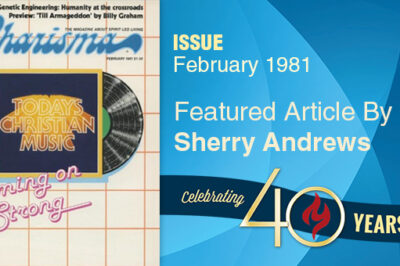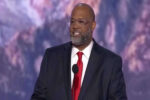Nineteen seventy-one was a banner year for Christians and Christian music. Jesus Christ became a “superstar” that year both on Broadway and in a “little country church” in Southern California.
Maranatha Music, the first “Jesus music” record company was formed and people everywhere began to “put their hands in the hand” of the Lord. B. J. Thomas, who was still a drug-addicted rock star, declared that the whole thing was “one mighty cloud of joy.”
An explosion was about to occur. In one decade Christian music and the entire Gospel music industry would be changed almost beyond recognition.
If 1971 sparked the explosion, there had been rumblings for some time. Church music, which hadn’t changed much in several hundred years had been experiencing birth pangs. Musicians like Ralph Carmichael, Thurlow Spurr and Cam Floria had been experimenting with more contemporary forms of music since the 1950s.
However, during the 50s and 60s the thought of bringing guitars or drums into the church was a sacrilege to many and up-tempo Christian music was often more welcome in the marketplace than in the church. Contemporary Christian music needed a vehicle to carry it to term and give it birth.
In the 1970s it found one. It was the Jesus movement and it would have a profound effect on churches and church music.
A spiritual revival among young people had been fermenting since 1967, particularly among the hippie communities on the West Coast. It burst on the national scene in 1971.
In June of that year Time magazine declared: “Jesus is alive and well and living in the radical spiritual fervor of a growing number of young Americans who have proclaimed an extraordinary religious revolution in his name. Their message: the Bible is true; miracles happen; God really did so love the world that he gave it his only begotten son.”
Other magazines had also picked up on the story. Newsweek did an article in March and the late Look magazine carried a multipage article in February.
The long-haired Christian hippie of the era became a stereotype. Typically, he was a former drug user. He wore tattered blue jeans and carried an oversized Bible (always the King James Version). He peppered his talk with plenty of “praise the Lord’s,” and “Jesus loves you’s,” and pointed heavenward whenever he met another “Jesus person.”
Any afternoon you might find him on a street corner handing out a free “Jesus newspaper.” When he wasn’t witnessing or reading his Bible, he would listen to “Jesus music.”
He was part of a generation that had been born with a transistor radio in its ear. Musk had always been an important part of his life. The acid rock of the 60s had taught him how to “tune in, turn on, and drop out,” of the straight life and into drugs, sex, and the hippie counterculture. When he got saved, it was only natural for him to use his music to tell about the new life he had found.
Larry Norman expressed the feelings of most Jesus people toward music in those days with the song, “Why Should the Devil Have All the Good Music?”
Norman arrived on the scene in 1970 which earned him the title of the Jesus music forerunner. But he was just one part of a larger movement. Soon to follow were Danny Lee and the Children of Truth with “One Way,” which became the hallmark of the Jesus movement.
Mylon LeFevre broke away from the LeFevre’s, one of the hottest Gospel groups and produced an album called simply “Mylon” which remains one of the best early Jesus L.P.’s.
The secular world, not wanting to miss out on a good thing, responded with “Jesus Christ Superstar,” and a new rendering of the Book of Matthew “Godspell.”
The Byrds declared that “Jesus was just alright” with them and Judy Collins recorded “Amazing Grace.” Johnny Cash, a giant in the country music industry, went public for the Lord as did Glen Schwartz, the lead guitarist of Pacific Gas and Electric.
The mother church of the Jesus movement, Calvary Chapel in Costa Mesa, California, began recording Jesus music on its Maranatha music label. Out of that church came some of the best and most enduring Jesus music, including albums by Love Song, The Way, Ernie Rettino, Debby Kerner, and Karen Lafferty.
Word, Inc., one of the giants in Christian publishing, established a Jesus music label, Myrrh, on which it released albums by Randy Matthews, Ray Hildebrand, Dove and a few of Thurlow’s more contemporary groups.
But if the Jesus movement gave contemporary Christian music more visibility, it did not guarantee acceptance. For every Calvary Chapel that accepted Jesus people with open arms, there were dozens of churches that rejected both Jesus people and their music. Jesus artists trying to eke out a living from their music found the going very tough.
They were frequent targets of vicious attacks by pastors and evangelists who hated music with a “rock beat.” The most famous of these was Bob Larson. A former musician himself, Larson delivered scathing attacks on rock music, calling it the “devil’s diversion.” He lectured in schools and churches, encouraging young people to destroy their rock records.
But Larson didn’t confine his attacks to secular rock. In 1971 he published a book called Rock and the Church, in which he blasted Jesus music, calling it a ‘blatant compromise.”
But not even Larson or the most rabid rock-haters could stop the flood of Christian rock. The dam had broken. Contemporary Christian music was here to stay. And it soon received some powerful help.
Pat Robertson, founder of Christian Broadcasting Network sponsored a Jesus music radio show hosted by Scott Ross. He allowed it to broadcast over the Christian Broadcasting Network, which gave Jesus music more legitimacy.
In 1972 it received another boost from a rather unlikely source—Campus Crusade for Christ.
As part of its Explo ’72, Student Congress on Evangelism, Campus Crusade sponsored a day-long concert in downtown Dallas. A number of Jesus musicians were invited to perform, including Randy Matthews, Larry Norman, Danny Lee and the Children of Truth, Andrae Crouch and the Disciples, Barry McGuire, Reba Rambo, Rita Coolidge and Kris Kristofferson.
For many of the 180,000 who attended, it was their first exposure to Jesus music. They discovered that not only was it not demonic, in many cases it was actually enjoyable and worshipful.
Following the success of Explo, outdoor festivals featuring Bible teaching and Jesus music became popular throughout the United States.
The first “Jesus festival” was held near Morgantown, Pennsylvania in 1973. By 1976, they had become almost a summer ritual in the eastern part of the country. That year more than 70,000 people gathered for festivals from Florida to Ontario.
Because they were usually sponsored by a church or a church-related group, Jesus festivals helped bridge the gap between Jesus musicians and churches.
Also invaluable was the help given to Jesus artists by already-established Christian stars such as Pat Boone. Many Gospel musicians and Jesus artists got their starts on Lamb and Lion Records, Pat’s own recording company.
But perhaps the biggest boost to contemporary Christian music came from within the movement itself. While much of the early Jesus music had been very rock, reflecting the hippie culture it had come from, by the mid-70s, a number of new groups and artists with a mellower, more “pop” sound had arrived to broaden the scope of Jesus music.
Artists like Evie Tournquist (now Mrs. Pelle Karlsson), the Imperials, Dallas Holm and the Archers, whose music was contemporary but carried traditional overtones, helped build a bridge between street music and church music.
By the late 1970s, contemporary Christian music had virtually revolutionized the entire field of Christian music.
In 1975, contemporary Christian music accounted for only 10 percent of Word, Inc.’s record sales. Five years later it had increased to 50 percent.
In the past ten years Word has increased to 75 its stable of contemporary artists. It started with fewer than a dozen.
Out of the J.T. Benson total roster of 77, there are 35 contemporary artists.
Sparrow Records began in 1976 with three artists. Today it produces albums for 15 contemporary musicians and groups.
In addition, there are a number of smaller labels featuring contemporary Christian music such as Spirit, Praise Records and Star Song. New Life Records distributes music by Cam Floria, who was an early forerunner of Jesus music.
Several labels also have developed which specialize in a particular style of music. Servant Publications distributes music for the Word of God Catholic community in Ann Arbor, Michigan. North American Liturgy Resources distributes the music of Father Carey Landy, St. Louis Jesuits and collections of songs for children.
There are a couple of labels which specialize in Messianic Jewish music: Messianic Records, Jews for Jesus.
In 1971, almost no radio stations played contemporary Christian music. Today there are hundreds.
Contemporary Christian music even has its own magazine, entitled appropriately, Contemporary Christian Music (CCM). Published monthly in Laguna Hills, California, it is a slick, authoritative publication. It features articles on a wide variety of Christian artists, record reviews, song and album charts, information on retail marketing, spotlights on contemporary Christian radio programs and news from around the industry.
Contemporary Christian musicians who once lived out of vans and ate pork and beans (cold) can now command four and five-figure fees for performances.
Even Bob Larson has modified his views. In an article in Religious Broadcasting (October 1980) Larson said: “While the popular music of the world has continued to degenerate … I’ve observed that much contemporary Christian music has grown in spiritual depth and quality.
“Some disturbing characteristics still exist, but on the whole, new sounds and musical forms are gradually being refined into an idiom that presents the gospel in a relevant and spiritually mature manner. We’ve come a long way from those youth musicals of the late sixties … Many of today’s young musicians are extremely talented and have a sincere desire to share their gift in a way that competes favorably with the production quality of secular record labels.”
But their new acceptance and popularity has brought new problems to contemporary Christian musicians. Having vanquished, more or less, their external foes, contemporary Christian musicians are discovering the truth of Pogo’s famous axiom, “We have met the enemy and he is us.”
Christian musicians are facing the dual problems of corruption and secularism which have traditionally plagued the church when it became too established and too successful.
While there is no evidence of widespread corruption among contemporary Christian musicians, the danger is very real and some artists have fallen prey to the traps of superstardom.
Artists like Keith Green, Evie, and Randy Stonehill have spoken out on the problem of immorality among Christian musicians and against a shallow spiritual commitment on the part of those who minister in music.
There is a growing realization that just because someone is an expert musician, that does not make him an effective minister of the gospel. A new emphasis is being placed on the need for consistent spiritual discipline and growth for Christian musicians.
There is also an increased awareness by Jesus musicians of the ego problems associated with stardom.
In an interview with CCM last year, Randy Stonehill commented on how easy it is for a Christian musician to get caught up in the glamour and the glory of the business and forget his calling. Many Christian musicians end up worshiping Jesus music instead of Jesus, he noted.
The negative effects of stardom do not apply only to individuals however. Contemporary Christian music has become big business. Recording and promoting L.P.’s is expensive and record companies can hardly be blamed for wanting to make a reasonable profit on their investment.
But in its eagerness to find and promote new talent and to produce records that sell, some wonder if money has not replaced ministry as the motive in much of the industry.
There is genuine concern that if Christian companies adopt the world’s methods, artists who are astute businessmen, but whose Christian commitment is sadly lacking, will prosper at the expense of more sincere but less experienced artists. The bigger the Gospel music industry gets, the greater is the chance for “counterfeit albums,” those with little message and recorded because they’ll sell.
Keith Green is one of those most concerned and he has chosen what many people see as a radical solution to the problem.
Green had recorded two very successful albums with Sparrow, Inc., but in late 1979 he announced that he was dropping out of the Gospel music industry.
He further shocked the Gospel music world by announcing that his next album would not be available in retail stores. It would be offered free, he said, or for whatever anyone requesting it could afford.
In an interview last year with CCM, Green explained his motives:
“I think it is wrong to put a price on an item that contains a spiritual message that came free from God,” he said. “If I was doing a disco album or an instrumental album, or even if I was an entertainer who happened to be a Christian, then it would be my product. It would be my skill, my trade. But since I’m foremost a minister, my music is just a tool to present my ministry. I feel that it is wrong for me to put any price that would exclude somebody that couldn’t afford it.”
Not many musicians are as radical as Green but almost all agree that there is room for improvement in contemporary Christian music.
Perhaps the problems and the promise for Christian musicians were best expressed by Mike Johnson in the song, “It’s Time We Returned.”
How will contemporary Christian musicians respond to this challenge? What shape will their “call” take in the 80s? Paul Baker, a former Word record executive and author of Why Should the Devil Have All the Good Music? has some ideas on that subject. Baker thinks there are at least six trends to watch for in the next few years.
-
There will be a renewed interest in praise and Scripture music, hymns, and the liturgical music of the church.
The praise songs—the handclappers and the handraisers—will continue to multiply and to bridge the gap between young and old. Traditional hymns will be rediscovered by youth. Modern arrangements such as those on the Maranatha album, “Hosanna,” and Gary Paxton’s latest will help young people rediscover the music of the church. Liturgical offerings such as “The Lord’s Supper” by John Michael Talbot have crossed denominational boundaries and are enjoyed by Catholics and Protestants alike.
-
More emphasis will be given to reaching adolescents and teens with Jesus music.
No one caters to adolescents as much as the secular industry, Baker notes. And unfortunately, while Christians were fighting over which kinds of music were blessed and which kinds were cursed, “Grease,” “Saturday Night Fever,” and The Village People were sweeping young people away.
The question is, he asks, “Do we have Christian music that speaks to the fans of those performers? It doesn’t need to be the same style of music they perform, but do we have Christian music that will reach them? That question will have to be looked at quickly and seriously as a whole army of pre-teens and teens strike out in search of some Truth. Christian music can deliver that Truth and should.”
-
Many Christian musicians will pay more attention to social issues and causes such as world hunger.
More and more musicians are becoming concerned and involved in crusades to communicate the world hunger problem through their music. As a result, benefit concerts such as the World Vision concert where Barry McGuire recorded his “Inside Out” album, will probably increase.
-
More secular musicians will become Christians.
Bob Dylan’s highly-publicized conversion to Christ was the most exciting event in music in recent years. Because he is a “musician’s musician,” long respected by thousands of music fans also, Dylan’s conversion has opened many previously locked doors. The secular press is obliged to cover Dylan, and he has been undaunted in his testimony for Christ. The result is a reluctant, if not amusing, coverage of a life-giving message in the least likely media.
Bob Dylan is only one of a number of pop and rock musicians who have become believers in recent years. Richie Furay, Roger McGuinn, Denny Correll, Maria Muldaur, B. J. Thomas, Leon Patillo, Donna Summers, Dan Peek, Paul Davis, Dion, Arlo Guthrie and a score of others joined Noel Paul Stookey, Barry McGuire, Cliff Richard and Pat Boone who were converted earlier.
-
Television will increase as a medium for spreading contemporary Christian music. Shows such as the 700 Club and the PTL Club got the ball rolling. Maranatha’s televised special “Hosanna USA” and Johnny Cash’s Youth for Christ Special, “Where Have All the Children Gone,” are examples of the increasing use of televised contemporary Christian music. We’ll see more in the ’80s, Baker predicts, including music featured on Christian television productions broadcast on secular stations.
-
More emphasis will be put on performing contemporary Christian music at prisons and juvenile detention centers. Groups such as the Resurrection Band from Chicago are playing at prisons and the music is hitting home.
Baker believes that the ’80s will be a decade of commitment for the music makers. They will be challenged to produce better music, to keep their motives pure and to live their Christian witness onstage and off.
And he also has a word for the Christian consumer.
“Those who listen to contemporary Christian music, those who buy records, and attend concerts also have a challenge for the ’80s: to better understand and support musicians, to unashamedly spread the word about CCM, to purchase Christian records and tapes for friends—unsaved friends especially, and to take them to concerts; to encourage, in a loving way, quality lyrics and meaningful songs from the performers, to be a better audience when attending Christian concerts.”
“And the most important of all things the audience can do,” he adds, “is to pray for the musicians creating and performing the music!”
Other artists and producers see the ’80s as the decade when Christian musicians will stop speaking just to the Christian community and begin penetrating secular markets with Gospel music.
Artists like Pat Boone, Debby Boone, B. J. Thomas, Andrae Crouch, Chris Christian, and Ed Raetzloff have been criticized by some in the Christian community for performing in secular places and recording on secular labels. But these artists say they feel very strongly about the need to reach the unchurched—to take their music to people who may never have heard the gospel.
Ed Raetzloff puts it bluntly: “I’m really aiming at the guys who are like I was, who are sitting around drinking tequila. I’m trying to communicate to the most amount of people with the message I want to communicate.”
How well contemporary Christian music will be able to accomplish that, and what other directions it will take in the next decade, no one really knows for sure.
About the only thing certain about contemporary Christian music is that it will continue to change. By definition, it must. Musical forms that were contemporary in 1971 are not contemporary in 1981. Although the message it presents is timeless, the medium—the music—must be continually changing and growing.
As John Styll, publisher of Contemporary Christian Music, puts it, “Contemporary Christian music is simply the new wineskin in which the message is presented to our culture.”






Leave a Comment
You must be logged in to post a comment.